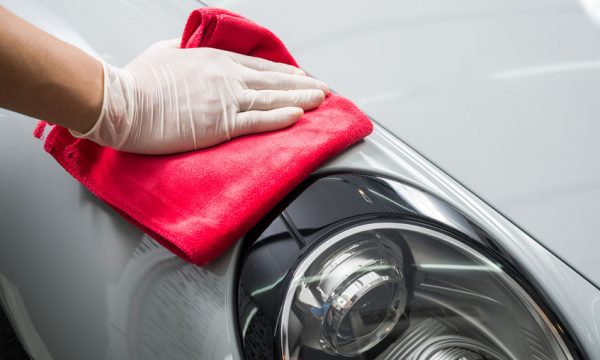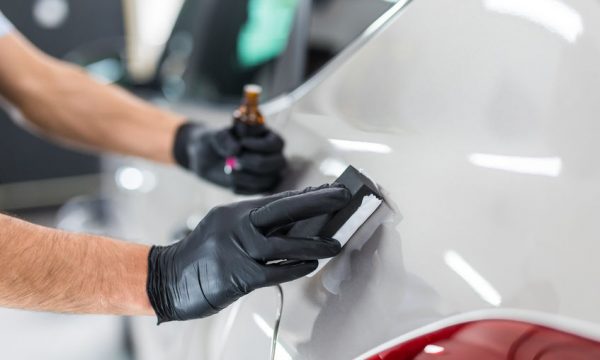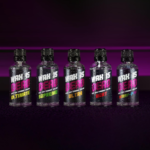


Ceramic Coatings
In simple terms a ceramic coating is a polymer based liquid that forms a protective layer or ‘shell’ when applied to automotive paintwork, including bodywork, wheels and glass. This protective layer is made up of nano-structured chemical components that bond with the top coat (lacquer) and, once cured, is not visible to the human eye.
There are several advantages of applying a ceramic coating, including:-
- Protection against UV, chemical and environmental degradation
- Increased resistance to ‘bonded’ contaminants such as tree sap, tar & bird lime
- Improved hydrophobicity (water repellency)
- Protects against minor scratches and abrasions
- Improves paintwork gloss & lustre
- Keeps the vehicle cleaner for longer & makes washing easier
There are several ceramic coating products available on the market, ranging from quartz to composite, with each offering varying degrees of performance, durability and longevity. Product performance is usually measured in it’s ‘h’ or ‘hardness’ value, just like a pencil. So, the higher the h value, the harder the ceramic coating is once cured and the most popular coatings range from 5 – 10h. Although other factors are taken into consideration, such as chemical and temperature resistance, generally speaking, the higher the h value, the longer the coating will last and the manufacturers guarantee will usually reflect this.
As an accredited Gtechniq and Wax Is Dead detailer, ArmourFactory exclusively recommend and promote these high performance ceramic coatings for cars and commercial vehicles. However, more recently, we have developed our own range of ceramic coatings specifically for motorcycles. Our popular ‘NanoTech’ range (see below) includes bodywork, wheel and perspex coatings designed for self-application and packaged in environmentally friendly quantities suitable for all types of motorcycle.
ArmourFactory NanoTech
NanoTech is a high-performance range of ceramic and hydrophobic coating products developed by ArmourFactory specifically for motorcycles. As the majority of high-end motorcycle ownership is based on occasional use, with riding conditions, heat dissipation, contaminant exposure and cleaning techniques all being different from that of a car, a product range with differing characteristics is required. Our NanoTech range meets this criteria and, whilst being of the highest quality, is also packaged economically to reduce wastage.


The range includes:-
- Clear Coat – Ceramic Paintwork Coating With 5 Year Durability
- Wheel – Ceramic Wheel Coating With 2 Year Durability
- Clean – pH Neutral Multi-Purpose Cleaner
- Leather – Hydrophobic Coating For Leather
- Perspex – Hydrophobic Coating For Fly Screens & Helmet Visors
All of the above items are sold individually or as a kit, supplied with accessories and application technique.
AVAILABLE NOW
Hydrophobic Coatings
As with ceramic coatings, hydrophobic coatings are ultra-thin, optically clear liquids that are applied to surfaces to repel water, dirt and other substances. When cured, the hydrophobic chemicals within the composite material allow water droplets and other liquid substances to simply rebound or ‘bead’ away from the surface.
In automotive terms, they can be applied as an additional layer for a ceramic coating to further enhance the water beading properties of the base coat (as with Gtechniq EXOv4) or they can be used as a stand alone product on a wide range of interior / exterior surfaces and materials including glass, fabric, upholstery, leather and alcantara.
As a typical example, if we were protecting an entire car at the highest performance / price level, we would use:-
- A ceramic coating on the exterior painted bodywork & trim
- A hydrophobic top coat on the exterior painted bodywork & trim
- A ceramic coating on the alloy wheels
- A ceramic coating on the windscreen and rear window
- A hydrophobic coating on the side windows & sunroof
- Hydrophobic coatings on the interior fabric, upholstery & leather
In addition to professionally applied products, there are a range of DIY sprays and quick detailers available (such as our Hydrophobia product) that can be used at home as a ‘top up’ to enhance the hydrophobic properties of your car or motorcycle paintwork following a wash. Our NanoTech Motorcycle Protection Kit includes all of the hydrophobic coatings that you would need for a motorcycle.
As with ceramic coatings, we exclusively use and endorse Gtechniq and Wax Is Dead hydrophobic coatings for cars and commercial vehicles and our own NanoTech products for motorcycles.
All Gtechniq, Wax Is Dead and ArmourFactory products can be purchased from our Online Store.


FAQ's
What Aftercare Is Required For A Ceramic Coating?
Just wash your car or motorcycle as normal but we ALWAYS advocate a ‘safe washing’ technique. Please see our blog article for further information. You can also increase the effectiveness of your ceramic coating by ‘topping up’ using a hydrophobic spray such as Gtechniq Liquid Crystal.
Can A Ceramic Coating Be Removed?
Yes. How easy it is to remove basically depends on how good it is. A cheap, low quality coating can easily be removed with a solvent based cleaner, isopropyl alcohol or panel wipe. A high quality, professional product, such as Gtechniq Crystal Serum Ultra, can only be removed by sanding the paintwork.
Will A Ceramic Coating Make My Paintwork Impenetrable?
No it won’t. It will add an extra layer of protection against dirt, environmental contaminants, UV damage and mild abrasions as well as making your paintwork slicker, glossier and easier to clean but it isn’t an impenetrable force field! It will offer very limited protection against minor stone chip and flying debris but it is not designed for this purpose.
Which Is Better, A Ceramic Coating Or Paint Protection Film?
They both serve different purposes, although paint protection film (PPF) has many of the features of a ceramic coating, including UV & contaminant protection, hydrophobic properties and a glossier finish. There is also a significant cost differential, with PPF being more expensive so this is worth taking into consideration. Choose a ceramic coating if you generally want to protect your vehicle against everyday wear and tear, make it easier to clean and make your friends envious of it’s deep glossy shine! Choose PPF if you are worried about deeper scratches, stone chips, missiles and flying debris.
If your budget allows, go for both! It is quite common to have the full front end covered with paint protection film to protect against forward facing hazards such as stone chips and road rash, whilst protecting the remainder of the car with a ceramic coating will provide a barrier against everyday pollutants and poor washing techniques.
Can You Apply A Ceramic Coating With PPF?
Indeed you can. You can apply PPF to certain areas of your vehicle and a ceramic coating to others. You can also apply a ceramic coating (such as Gtechniq HALO) as a top coat on the PPF itself. This will further enhance all of the integral properties of the PPF whilst adding additional benefits of its own, such as improved water repellency and more balanced gloss levels. Like most car detailing processes, there is always an offset of cost against results and the phrase ‘diminishing returns’ comes to mind.
One common question is whether or not you can install PPF over a ceramic coating (potentially as an afterthought) and, surprisingly, there is no definitive answer. Common sense would suggest that, because the ceramic coating is designed to repel foreign objects, it will also repel the adhesive used to bond the PPF. However, there is no actual evidence of this being the case as the adhesive typically used on PPF is extremely strong and robust. Nevertheless, as a qualified detailer and professional PPF installer, we would always try and remove a ceramic coating prior to installing PPF, if only as good practice if nothing else!
What Is The Difference Between Wax & A Ceramic Coating?
Basically, a carnauba or synthetic wax is the original, well proven and time served version of a ceramic coating. It was the only finishing product available for your automotive paintwork up until the introduction of ceramic coatings and nano technology. A good quality car wax offered all of the benefits of a modern day ceramic coating, but to a far lesser extent and without the longevity.
As a ceramic coating physically bonds with the vehicle’s paintwork, it fundamentally changes the composition or structure of the clear coat at a molecular level whereas a wax simply ‘sits’ on top of the paint surface. Obviously it is a little more complex than this but, suffice to say, for this reason, we would never advocate the use of a ceramic coating on a high value, concours classic car or motorcycle with original factory paintwork as the provenance of the vehicle would be compromised. Rather, the use of a good quality wax such as a Swissvax product would be our preference.
There are a number of waxes available today that offer advantages in certain circumstances over and above a ceramic coating, the case in point being the last paragraph. For example, if you enjoy the process of waxing your own car, you may choose an everyday wax that will offer a combination of protection, water repellency and gloss whilst lasting for 6-12 months. On the other hand, if you are entering your vehicle into a concours event or show, you may choose a wax that is extremely slick and glossy with a mirror like or ‘wet’ finish, but one that will not last the drive home if it is pouring with rain!
If I Put A Hydrophobic Coating On My Windscreen, Do I Not Need To Use Windscreen Wipers?
During ‘around town’ and relatively low speed driving, the answer is yes, you will still have to use your wipers but more intermittently than normal. At higher speeds and motorway cruising, with a good quality hydrophobic coating, you will find that the rain water simply dissipates or ‘beads’ off the windscreen and you may not have to use your wipers at all.
Will A Hydrophobic Coating On My Interior Protect Against Spillages?
Yes, a good quality hydrophobic coating that has been applied correctly will protect against spillages, such as water, soft drinks or coffee, as the liquid will simply sit or ‘bead’ on the surface of the material and will not penetrate deep into the fibres. You can then wipe or vacuum up the spillage as soon as you get chance. The same can be said for motorcycle seats, grips or panniers that are made from fabric or leather which will also be protected against water during rainfall or whilst cleaning.
Can I Use A Ceramic Coating On My Motorcycle Helmet?
This is subjective as there doesn’t seem to be any particular reason why not. However, the process and chemical components in the lacquer used on a crash helmet are different from those used on a car or motorcycle’s bodywork. Not least the fact that they are used more sparingly to produce a thinner, lighter finish could be of significance.
We have been asked to coat a number of motorcycle, motorsport and cycling helmets with a ceramic coating over the years and have always declined on the basis that we would be adding a chemical to the factory finished surface of a safety device. Most good quality helmet manufacturers will stipulate in their product manuals that chemicals and solutions should not be used on their products, if for no other reason than it would invalidate the warranty. Our concern in this respect is not one of a warranty invalidation, rather one of a safety concern as any chemical application could compromise the integrity of the helmet.







